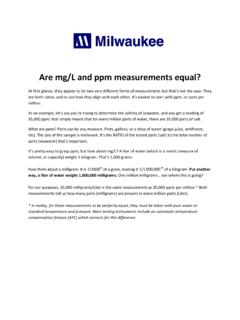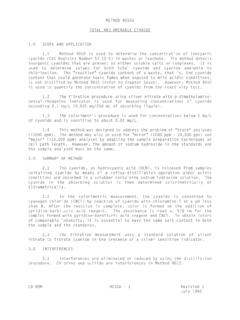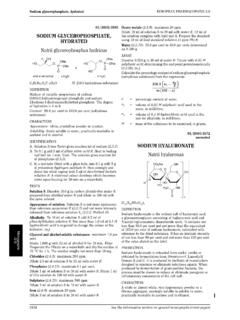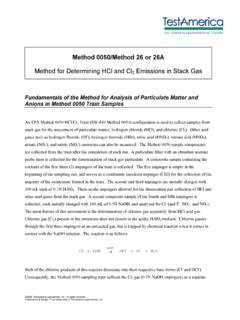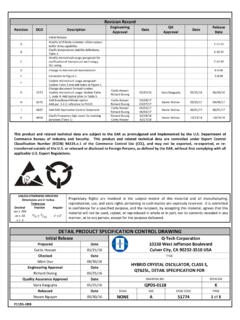Transcription of Fact Sheet: Bioprocess Intelligent Optimization …
1 Modified Ludzack-Ettinger (MLE) activated sludge ProcessBIOS ImplementationFeatures Calculates optimal DO and IRQ set-points Feed-forward, real time control Monitors real time influent and operating data Works with existing plant infrastructure Real time process simulation using the activated sludge Model Communicates with plant SCADA system Allows remote monitoring and control Easy to install and operate Touch screen user-interface Self-calibratingBenefits Reduces blower energy by up to 25% and total plant energy by up to 15% Provides an environment for optimal biological performance Optimizes nitrogen removal in the MLE process Stabilizes the process Manages plant start-up, maintenance.
2 And recovery conditions Maximizes oxygen transfer efficiency Quick return on investmentFact Sheet: Bioprocess Intelligent Optimization System ( bios )The bios is an integrated hardware and software solution that enables real-time monitoring and dynamic control of Biological Nutrient Removal (BNR) processes, such as the MLE process . The bios process control algorithms optimize operation of the BNR process , making adjustments to account for the variable influent loading and biological activity in the bios consists of a controller and nutrient analyzers. The bios controller calculates optimal Dissolved Oxygen (DO) and Internal Recycle Flow (IRQ) set-points based upon real-time measurements from the nutrient analyzers, and transmits the set-points to the plant SCADA system for use in plant and BenefitsDO Control TheoryThe bios DO Set-Point Controller calculates the optimal DO set-point(s) to treat the BOD and ammonia loading.
3 Optimizing the DO set-point(s) decreases the aeration requirements and increases the oxygen transfer efficiency, ultimately resulting in energy ammonia analyzer located in the last anoxic zone provides the control system with the ammonia concentration entering the aerobic zones. Utilizing the measured ammonia concentration along with other measured parameters such as flow rates, DO, and MLSS, the bios DO Set-Point Controller conducts biological and hydraulic simulations to predict how the DO concentration will effect the final effluent quality. The optimum DO set-point(s) is the minimum DO concentration required to meet the effluent quality goals. An effluent ammonia analyzer is used to confirm the simulation results and automatically adjust model parameters if Control TheoryThe bios IRQ Set-Point Controller calculates the IRQ set-point required to maximize denitrification performance.
4 Optimizing the IRQ set-point results in several benefits including: minimizing effluent total nitrogen, maximizing oxygen credits generated in the anoxic zone(s) to reduce aeration requirements, and minimizing IRQ pumping nitrate analyzer located by the IRQ pump inlet provides the control system with the nitrate concentration in the IR stream. The controller conducts iterated biological and hydraulic simulations that predict the effluent ammonia and nitrate concentrations under different IRQ rates. The optimum IRQ set-point is the value that results in the lowest effluent ammonia and nitrate Ludzack-Ettinger (MLE) process DescriptionBIOS Control TheoryAnoxicAerobicSecondary ClarifierReturn activated SludgeWasteActivatedSludgeInfluentEfflue ntInternal Recycle FlowNH3/NO3NH3 Plant ControlCenterBIOSP lant dataOperating dataSet-pointsControlActionsThe Modified Ludzack-Ettinger (MLE) process has been developed for the combination removal of BOD, ammonia, and nitrate/nitrite.
5 The process employs a combination of an anoxic and aerobic zone. Nitrification (ammonia removal) occurs in the aerobic zone. The mixed liquor, high in nitrate from nitrification, is recycled to the anoxic zone (by the internal recycle) for denitrification. Typical IRQ rates range from 200 400% of the process influent flow rate. The MLE process can achieve a 6 to 8 mg/l Total Nitrogen discharge, depending upon the wastewater influent TN Reduction with BIOS20% Airflow Reduction with BIOSBIOS Versus Fixed Set-PointsTotal Airflow02004006008001000120014000:006:00 12:0018:000:006:0012:0018:000:006:0012:0 018:000:00 Time of DayAirflow (SCFM) bios AirflowFixed AirflowAverage = 690 SCFMA verage = 548 SCFME ffluent Total Nitrogen024681012141618200:006:0012:0018 :000:006:0012:0018:000:006:0012:0018:000 :00 Time of DayConcentration (mg/L) bios TNFixed TNAverage = mg/LAverage = mg/L3620 Horizon Drive, Suite 200 King of Prussia, PA 19406 Phone: 610-768-9360E-mail.
6 SpecificationsControl PanelCalculation Frequency15 MinutesProgrammable Logic Controller (PLC)CompactLogix L35E or EqualIndustrial ComputerPanelView 1000 (Allen Bradley) or EqualDimensions (HxWxD)33 x 24 x 11 inchesWeight115 RatingsNEMA 4X, IP 66 Temperature Rating-21 to 131 F (-30 to 55 C)AC Power Supply115 VAC 60 HzAverage Current Consumption5 AMaximum Current Consumption8 AUser InterfaceAnalog resistive touch screenProtocolEtherNet/IP messages encapsulated within standard TCP/UDP/IP protocol, or MODBUS TCP/IPCommon Application LayerControlNet and DeviceNetCableCategory 5 twisted pair cableSpeedHalf/Full Duplex 10 Mbit or 100 Mbit operationNutrient AnalyzerMeasurement ParametersAmmonia and NitrateMeasurement TypeIon-Selective, In-situMeasurement ppmReproducibilityWithin 5%Calibration MethodAutomaticCalibration FrequencyVariable (operator settable)Accuracy+/- 5 % of measurement or +/- ppm (whichever is larger)
7 Temperature Rating (Controller system)-21 to 140 F (-30 to 60 C)Sample Temperature34 to 122O F (1 to 50 C)AC Power Supply115 VAC 60 HzAverage Current Consumption1 AMaximum Current Consumption5 AInternal Data Storage150,000 time-stamped measurementsOutput Signals4-20 mA, MODBUS, RS-485, RS-232, RS-422 Relays / Alarms(4) relays as follows: High and Low levels detected for Ammonium and Nitrate Concentration. (1) alarm condition for Low Calibration Solution / Reagent Warning and for Empty Calibration Solution / Reagent Automatic analyzer ScreenDaylight readable QVGA LCD
